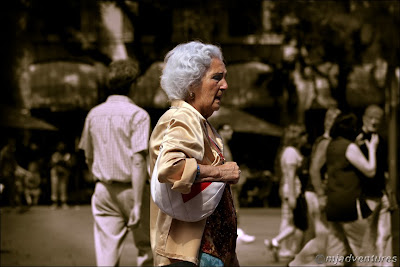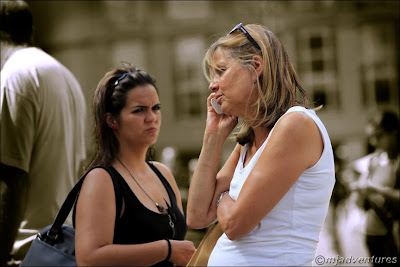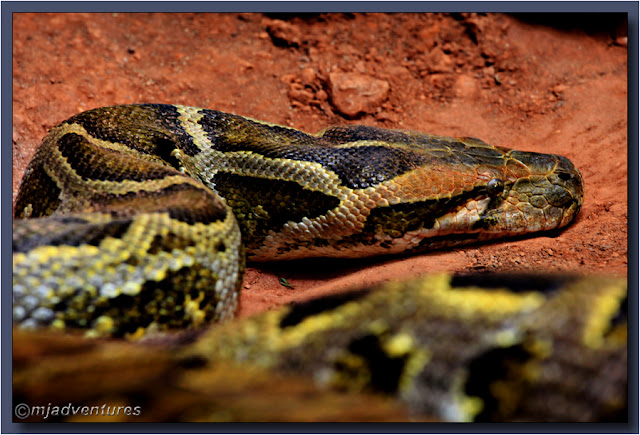Not visited by many tourists is the CosmoCaixa Science Museum in Barcelona. The reason for this is that the website is only in Català and Castellano, making it a little difficult for other-language speakers to find out much about it. This is a disservice to the museum, as it truly is spectacular and worth visiting. It's an activity to do on a rainy day, or even a stinking hot day when it's too uncomfortable to be outside.
Official website in Català and Castellano
Info about the museum in English
What makes it even more attractive is the entry fee - only €3 per person at the time of writing. At this price, it's one of the most inexpensive attractions that Barcelona has to offer, and will keep the kids amused for some time - especially with the hands-on exhibits.
The winding entryway explores life from the very beginning of time
We've found that the easiest way to get to CosmoCaixa is to catch the L7 metro line from Plaça Catalunya to the end station at Av. Tibidabo. From there, the museum is a 10 min., 800m uphill walk - not good when there are young children or in adverse weather conditions. Instead, catch the #123 bus (one of the smaller buses) which leaves from the bus rank across the road from the station - at the foot of Av. del Tibidabo and on Passeig de Sant Gervasi. If you tell the driver that you want to go to CosmoCaixa, he'll tell you where to get off the bus. It's less than a 5 minute ride, but will save you from the whinging! Alternatively, the #196 bus leaves its stop from just above the Blue Tram stop at the bottom of Av. del Tibidabo, and also passes the museum.
The museum can be very busy - especially on wet days or holidays. Getting there early helps to avoid the sometimes lengthy queues lining for tickets. The museum is open from Tuesdays to Sundays (10am - 8pm), and closed most Mondays (except for holidays), Christmas Day (25th December), New Year's Day (1st January) and Kings' Day (6th January).
Looking up at the entryway from the base
Aside from the temporary exhibits, the museum has 8 permanent display areas.
La Plaza de la Ciencia:
The Science Plaza is located in the open air outside the museum and is free. However, it's not very interesting and wasn't enough to hold the attention of J's kids for very long.
El Muro Geológico: The Geological Wall stretches along the entire length of the museum, and uses 90 tons of rock to demonstrate how natural forces have shaped planet Earth. There is also an interesting video on how some of the rock wall was lifted out of its natural state and prepared for exhibition in the museum.
The geological wall can be seen on the mezzanine floor
El Bosque Inundado: The Submerged Forest is 1,000 sq. meters of
simulated Brazilian rainforest, housing living flora and fauna - mostly in the form of the various types of aquatic life. We love this display.
A large equatorial fish and its reflection
Every so often, a simulated rainstorm pours from the roof in a display of how heavy the equatorial rainstorms can be.
Equatorial rainfall simulation
Looking down into the Brazilian Rainforest exhibit
La Sala de la Materia: The Matter Room explores "matter" - what else! It deals with the theory of the Big Bang up until present day, and tries to answer that age-old question, "What is Life?"
The main floor of the museum
Planetario: The Planetarium is a 3D journey through space and time,
experiencing galactic events usually only seen in science fiction movies. We have yet to visit the museum when the Planetarium is open, and it's the only exhibit where the commentary is in English as well as Català and Castellano.
Measuring time with a perpetual pendulum using the earth's rotation for momentum and direction
Clik and Flash:
The 'Clik' and 'Flash' rooms are for children between 3 and 9yo. and are located on the upper level of the museum. There are set times for these rooms to be open, so if you're interested in them, go upstairs and check the times which are displayed outside the main door to the rooms.
Discovering how the tectonic plates have shifted the continents
Planetario Burbuja: The Bubble Planetarium is astronomy for children between 3 and 8yo.
Looking down on the main floor
¡Toca toca!: Touch Touch! challenges the 5 senses - touch, smell, hearing, taste and sight - to learn more about the world's flora and fauna, in an attempt to gain more understanding and respect for the natural habitats. It's a lesson in conservation.
The natural history area
The main museum floor is mostly dedicated to anthropology, mathematics and physics. It's here that J's kids get most pleasure from the puzzles and hands-on challenges. The big block of frozen ice and the strobe-lit ping-pong balls are hot favourites!
Ping pong balls in motion and illuminated by a strobe light
Seeds displayed in test tubes
Although the museum has a cafeteria, we have always brought our own food, and there are plenty of places to sit and eat.
An exhibit demonstrating the effects of various drugs on the human body
J's kids have been to Barcelona twice now, and each time they've been really enthusiastic about visiting CosmoCaixa. They're returning this week, so it's likely that we'll be going again!
The rainforest area
Another view of the main hall
Museum location on Google Maps:
View Larger Map



















































